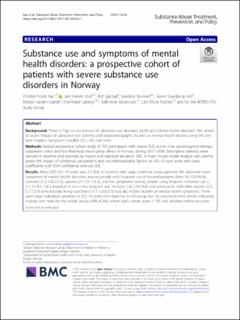Substance use and symptoms of mentalhealth disorders: a prospective cohort of patients with severe substance use disorders in Norway
Aas, Christer Frode; Vold, Jørn Henrik; Gjestad, Rolf; Skurtveit, Svetlana; Lim, Aaron G.; Gjerde, Kristian Varden; Løberg, Else-Marie; Johansson, Kjell Arne; Fadnes, Lars T.
Peer reviewed, Journal article
Published version
Permanent lenke
https://hdl.handle.net/11250/3010953Utgivelsesdato
2021Metadata
Vis full innførselSamlinger
- Artikler [5068]
- Publikasjoner fra CRIStin FHI [7544]
Originalversjon
Substance Abuse Treatment, Prevention, and Policy. 2021, 16 (20), . 10.1186/s13011-021-00354-1Sammendrag
Background:There is high co-occurrence of substance use disorders (SUD) and mental health disorders. We aimedto assess impact of substance use patterns and sociodemographic factors on mental health distress using the ten-item Hopkins Symptom Checklist (SCL-10) over time.Methods:Nested prospective cohort study of 707 participants with severe SUD across nine opioid-agonist-therapyoutpatient clinics and low-threshold municipality clinics in Norway, during 2017–2020. Descriptive statistics werederived at baseline and reported by means and standard deviation (SD). A linear mixed model analysis was used toassess the impact of substance use patterns and sociodemographic factors on SCL-10 sum score with betacoefficients with 95% confidence intervals (CI).Results:Mean (SD) SCL-10 score was 2.2 (0.8) at baseline with large variations across patients. We observed moresymptoms of mental health disorders among people with frequent use of benzodiazepines (beta 3.6, CI:2.4;4.8),cannabis (1.3, CI:0.2;2.5), opioids (2.7, CI:1.1;4.2), and less symptoms among people using frequent stimulant use (−2.7, CI:-4.1;-1.4) compared to no or less frequent use. Females (1.8, CI:0.7;3.0) and participants with debt worries (2.2,CI:1.1;3.3) and unstable living conditions (1.7, CI:0.0;3.3) had also higher burden of mental health symptoms. Therewere large individual variations in SCL-10 score from baseline to follow-up, but no consistent time trends indicatingchange over time for the whole group. 65% of the cohort had a mean score > 1.85, the standard reference score.Conclusions:People with SUD have a considerable burden of mental health symptoms. We found no associationbetween substance use patterns and change in mental health symptoms over time. This could suggest that thedifferences observed were indicating flattening of effects or self-medication to a larger degree than medication-related decline in mental health. This call for better individualized mental health assessment and patient care. Keywords: Substance use disorder, Substance abuse, Mental disorder, Psychological distress, Mental healthproblems, Opioid substitution treatment, Opioid dependence
